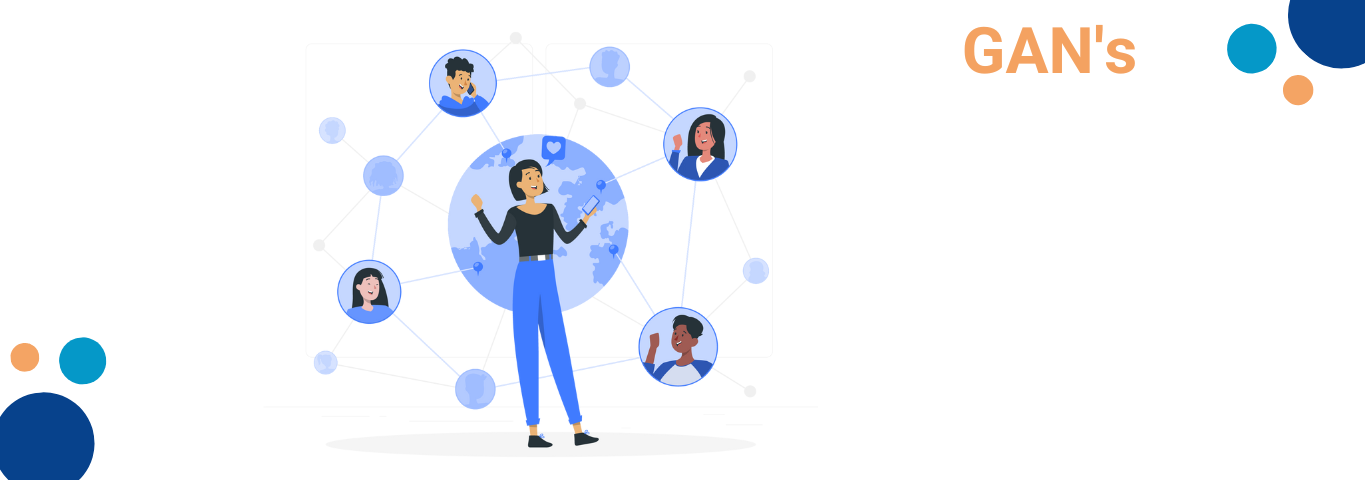Artificial intelligence (AI) has a remarkable ability to learn and create. One of the fascinating applications of AI in the field of creativity is Generative Adversarial Networks (GAN). GANs have revolutionized the field of generative modeling, enabling the generation of realistic and novel content.
This blog post will explore the fascinating world of GANs, their architecture, training process, and diverse applications across different domains.
What are Generative Adversarial Networks (GANs)?
Generative Adversarial Networks, introduced by Ian Goodfellow and colleagues in 2014, consist of two key components: a generator and a discriminator. GANs are a class of deep learning models designed to generate synthetic data such as images, music, text, and more that closely resemble real samples.
The generator generates synthetic data, while the job of the discriminator is to distinguish between real and fake data. These two components compete and improve over time through an adversarial training process, resulting in increasingly realistic and higher-quality outputs generated.
GAN architecture and training process:
- Generator: A generator takes a random input, usually a noise vector, and maps it to an output space. It transforms the input noise into synthetic data that mimics the training data distribution. The generator is typically implemented using deep neural networks such as convolutional neural networks (CNNs) for image generation.
- Discriminator: The discriminator, also implemented using neural networks, learns to distinguish between real and generated data. It takes the input data and outputs a probability indicating the probability that the input is true or false. The objective of the discriminator is to classify the real samples as real correctly and the generated samples as fake.
- Adversarial Training: The generator and discriminator are trained simultaneously in an adversarial manner. Initially, the generator produces crude outputs, and the discriminator quickly identifies them as false. However, as training progresses, the generator improves its ability to generate more realistic samples that fool the discriminator. This iterative process of generator and discriminator competition leads to the improvement of both models.
Advanced GAN Applications:
- Image Synthesis and Editing: GANs have significantly contributed to image synthesis and editing. They can create realistic images, create new variations of existing images, and even reconstruct missing parts of images. GANs have been used to transfer styles, paint, and generate photorealistic images.
- Video generation: GANs can extend their generative capabilities to video data, enabling the generation of new video content. It has applications in video synthesis, video prediction, and video completion.
- Text-to-Image Synthesis: GANs can bridge the gap between text and images by generating images based on textual descriptions. This has implications for creating visual content from text prompts and helps generate content for storytelling or game development.
- Voice and Music Generation: GANs have been used to synthesize realistic human voices and compose music. By training on large datasets of voice recordings or music tracks, GANs can generate new audio content that resembles the distribution of the training data.
- Data Augmentation and Anomaly Detection: GANs can be used to augment data and generate additional training examples to enhance the performance of machine learning models. GANs can also be used for anomaly detection, learning the normal distribution of data, and identifying deviations from it.
Understanding GANs
GANs were first introduced in 2014 by Ian Goodfellow and his colleagues and have since become a popular topic of deep learning research. GANs consist of two neural networks trained together: a generator and a discriminator. The generator creates new data samples while the discriminator evaluates them to determine whether they are real or false. The two networks are trained competitively, with the generator trying to trick the discriminator into believing its samples are real and the discriminator trying to identify real samples from fake ones correctly.
Training GANs
Training a GAN can be challenging as it requires balancing the learning of both networks to achieve the desired output. One common approach is to alternate training between the generator and the discriminator, updating one network and freezing the weights of the other. This method is known as alternating gradient descent and is the most widely used method for training GANs.
Improving GAN performance
GANs can be optimized in several ways to improve their performance. One approach is to add regularization techniques such as weight loss, dropout, or early stopping to avoid overfitting and improve the generalization of the networks. Another approach is to use different loss functions, such as Wasserstein loss or hinge loss, to enhance the stability and convergence of the networks.
Conclusion
Generative Adversarial Networks (GANs) are pushing the boundaries of creative AI, enabling machines to generate realistic and novel content in various domains. With their robust architecture and adversary training process, GANs have transformed image synthesis, video generation, and text-to-image synthesis.






Comments